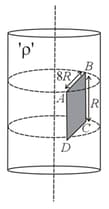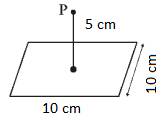Gauss Law
Gauss Law: Overview
This Topic covers sub-topics such as Electric Flux, Gauss Theorem in Electrostatics, Area Vector, Electric Field Due to Two Parallel Charged Infinite Sheets and, Gaussian Surfaces for Various Charge Distribution
Important Questions on Gauss Law
A hollow charged metal sphere has radius . If the potential difference between its surface and a point at a distance from the centre is, then electric field intensity at a distance is:
What is the electric field inside a charged conductor ? Plot a graph between electric field strength and distance from centre in case of a charged conducting sphere of radius .
Assertion: Gauss's law can't be used to calculate electric field near an electric dipole.
Reason: Electric dipole don't have symmetrical charge distribution.
Gauss law is applicable only when there is a symmetric distribution of charge.
A Gaussian sphere encloses an electric dipole within it. The total flux through the sphere is
Flux coming out from a unit positive charge enclosed in air is
A conducting spherical shell of radius has a charge units. The electric field due to the shell at a point
A non conducting solid cylinder of infinite length having uniform charge density and radius of cylinder is . Find the flux passing through the surface as shown in figure.

State Gauss' theorem in electrostatics and write its expression.
The electric potential at the surface of a charged spherical conductor of radius is . Electric potential at its centre in volt is
An electron of energy is fired from a distance of perpendicularly towards an infinite charged conducting plate. What should be the minimum charge density on plate so that electron fails to strike the plate?
A large uniformly charged sheet having a surface charge density of lies in plane. Calculate the electric flux through a circular loop of radius whose axis makes on angle of with axis.
A particle of mass is placed at some height above a uniformly charged horizontal infinite non conducting plate having a surface charge density . What should be the charge on the particle so that on releasing it will not fall down. Take,
Two metallic plates each of area is placed parallel to each other at a separation of . Both have charges of equal magnitude but of opposite nature. If the magnitude of electric field in space between them is , then calculate the magnitude of charge on each plate.
A charge of is given to a metallic plate of area . Determine the intensity of electric fields at points near by.
A charge of is placed directly above the centre of a square of side at a height of as shown in the figure. Determine the magnitude of electric flux through the square?

An infinite line charge produces an electric field of at from it. Determine the linear charge density.
The intensity of electric field due to a charged sphere at a point at a distance of from in centre is . The radius of sphere is . Determine the intensity of electric field at a distance of from the centre.
Consider a cube of side , Let a charge be placed at one face of the cube. Calculate the total flux linked with cube and comment on the flux linked with each face.
Consider a cube of side , Let a charge be placed at one corner of cube. Calculate the total flux linked with cube and flux linked with each face.
